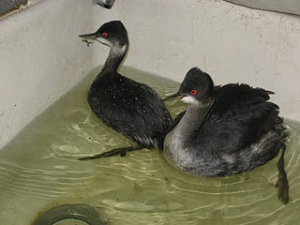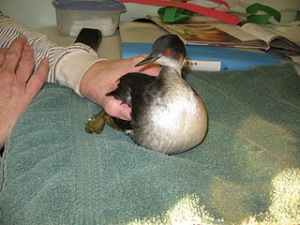 Late one night last December, it began snowing Eared grebes in Cedar City, Utah. They landed not with a whisper, but with a thud.
Late one night last December, it began snowing Eared grebes in Cedar City, Utah. They landed not with a whisper, but with a thud.
There was snow on the ground and stormclouds in the sky, and the ruby-eyed, duck-like birds were flying to Mexico for the winter. Clouds obscured the stars, which the birds use for navigation, and the city lights made large, flat areas appear to be bodies of water. The birds flew down to rest on what looked like lakes, ponds and streams, and instead crashed onto what turned out to be parking lots, fields, and roads. Over 3,500 went down, and at least 1,500 were injured or killed.
Residents rallied to help the birds, picking them up and delivering them to the Division of Wildlife Resources, a state government agency located right in Cedar City. Wildlife officials responded by taking nearly all of the birds and tossing them into local lakes and ponds, despite the fact that so many were clearly injured. “Birds’ hollow bones can heal,” DWR spokesman Lynn Chamberlain told the Christian Science Monitor, “although humans can’t do much to help the process.”
This came as a surprise to wildlife rehabilitators all over the country, as most of us have spent a good part of our lives working with veterinarians and setting the broken bones of birds – knowing that if the bones are misaligned or shattered they will never heal, and if the bone is broken at the joint, the bird will never fly again. This is what wildlife rehabilitators do: assess the injured, fix the fixable, and give the lost causes a humane death so they don’t suffer.
“No, the Department of Wildlife Resources never called us,” says Martin Tyner, a rehabilitator who runs Southwest Wildlife Foundation (www.gowildlife.org), which is also located right in Cedar City. “The public did, though. Our phone was ringing off the hook all night.”

There isn’t a bird rehabber on the planet who wouldn’t shudder at the thought of rehabbing a large number of injured grebes, a species notoriously difficult to care for. Most would agree that if a grebe were slightly injured, its best chance would be to release it into water, and not put it through the stress of rehab. However, the key word here is slightly.
“They’re diving birds, so they use their legs to get their food, but they don’t use their wings,” said DWR spokesman Chamberlain, when I called to ask about the event. “We didn’t have any with broken legs.” Again, this is quite a surprise – over 3500 birds landing feet-first on cement, and not a broken leg among them. “Some of their wings were pretty bad off, though,” he continued. “Some of them had wings almost amputated.”
Question: What do you do with a bird whose wing is almost amputated? Answer: Throw it in the water. And whatever you do, don’t call a rehabber.
“DWR never even contacted us,” says Debbie Souza-Pappas, the founder of Second Chance Wildlife Rehabilitation in Price, two hours away. “Of course we would have driven down there to help. At least we could have done triage, and dealt with the ones who had terrible injuries. But as usual, we were completely out of the loop. We have the skills, the knowledge, the licenses, and we care about these birds – but DWR will not work with us. It’s infuriating.”
The day after the incident Marlene Gunderson, who lives in St. George, was driving with her husband and found a grebe lying in the middle of the road. They didn’t know about wildlife rehabilitators, so they stopped, picked it up, and took it to their vet, who told them they had to call DWR. Marlene took the bird home, dutifully called, then waited while the operator located a DWR officer.
“It’s almost a holiday,” said the officer, even though it was December 13. “I doubt if I’ll find anyone to help you.”
“But you have to!” cried Marlene. “I’ll drive him wherever he needs to go!”
“Ma’am,” he replied. “This isn’t a matter of life or death.”
“It is for the bird,” said Marlene.
“Maybe I can get Animal Control,” said the officer. The grebe died a few hours later.
 “This isn’t the first time a bird crash has happened, and it’s going to happen again,” says rehabber Debbie Souza-Pappas. “Are we going to have to watch more YouTube videos of birds with broken wings being thrown into lakes, or can rehabbers work out a protocol with DWR? Look how many people were out in the middle of the night, picking up grebes and trying to help them! Obviously the public cares what happens to these birds. It’s crazy that there are qualified people ready and willing to help, and a government agency – which is supposedly set up to protect Utah’s wildlife – won’t work with us.”
“This isn’t the first time a bird crash has happened, and it’s going to happen again,” says rehabber Debbie Souza-Pappas. “Are we going to have to watch more YouTube videos of birds with broken wings being thrown into lakes, or can rehabbers work out a protocol with DWR? Look how many people were out in the middle of the night, picking up grebes and trying to help them! Obviously the public cares what happens to these birds. It’s crazy that there are qualified people ready and willing to help, and a government agency – which is supposedly set up to protect Utah’s wildlife – won’t work with us.”
“There are a lot of grebes still on the ponds,” said DWR spokesman Chamberlain, more than two weeks after it happened. “They don’t seem to be migrating.”
First photo by Howard B. Eskin; second two by Debbie Souza-Pappas, Second Chance Wildlife Rehabilitation, http://wildliferehabilitationinutah.blogspot.com secondchancewildliferehab@yahoo.com

Wow,, unbelievable, I guess they figured “not my job”,and just get thru it as simply as possible,dump them in the lake.Horrific really.
p.s. I am a migratory songbird rehabber in N.C.
COME ON!!!
It’s like watching a horror movie reading this story! Absolutely heartbreaking that this could happen to so many souls- birds AND kind, well meaning people. What a betrayal by the DWR.
I`m a federally-licensed wild songbird rehabilitator in Michigan and this doesn`t surprise me at all.The public is under the misconception that conservation officers are all about helping the wildlife if animals or birds are injured or orphaned.This is clearly not the case in the county I live in,as well as many others.They tell the public to leave orphaned, injured birds & animals alone and “let nature take it`s course”.One officer has told me that if he had his way about it,there would be NO wildlife rehabilitators.It seems their primary job is collecting fees,fines,and license money to hunt federally protected wildlife.
Theresa, I am the rehabber in this story from Second Chance Wildlife Rehabilitation and our wildlife people are exactly the same here, including telling the public and we rehabbers to ‘let nature take it’s course’. When I bring up that nature had nothing to do with the situation we are dealing with and we rehabbers can actually intervene to prevent a situation from happening that we usually hear about when it’s too late, I’m told “things could go bad for you if you chose to ignore what we said” Clearly a threat.
Teresa in MI. I agree.
Thanks,Evangeline. You & I both know why those birds are not migrating.They`re injured and sadly they will die on the ponds & lakes the conservation officers threw them in.
Things need to change! There are many really good, dedicated wildlife officers but they sure don’t seem to be the majority. I love the phrase “Let Nature take its course” – when 95% of wildlife injuries are human-caused! Hello?
Caring for animals and injured wildlife is a basic way that humankind shoes Love for God our Creator. Government agencies and their employees who do not help its citizens do that fail to understand its purpose and have no real vision for their existence. Citizens need someone to be in charge and in authority but that someone should be accountable to laws that define their activities in the most highest manner of human cooperation, coordination and communication, with total transparency and three way information flow. This tragedy
demonstrates the ineffectiveness of isolated hierarchy rather than the true public service that effective government is required to be.
Well said…I think us humans owe it to wildlife to help in those few instances that we can, a tiny drop in the bucket for the vast detriment we typically cause. I will, however, say that I know some really great people that work for the Fish and Wildlife Service here in Montana.
BTW, we got a few downed grebes as far north as Bozeman, Montana early last December. They landed in the wrong places and then could not take off again without a watery runway. The Raptor Center (the only wildlife rehab center around) differed all the calls to me as they can’t take non-raptors. This was my first experience with these very interesting and ancient birds. I was lucky that there were not hundreds, mercy, what would I have done?!!!!! The DWR in Utah doesn’t realize how fortunate they are to have qualified, able and willing rehabilitators right there, just a phone call away. I wish they would put big egos aside and do what is best for the animal.
Oh, and I wrote a little blog about the origins of the U.S. Fish and Wildlife Service, and it wasn’t to help wildlife. Should anyone care…
http://hubpages.com/t/22663e
(Don’t worry Suzie, I’m not being spammy here or trying to sell anything… links are a good thing!)
Thank you all for your comments. And Emily, your blog was great and I encourage everyone to read it! The more information we have the better.
http://hubpages.com/t/22663e